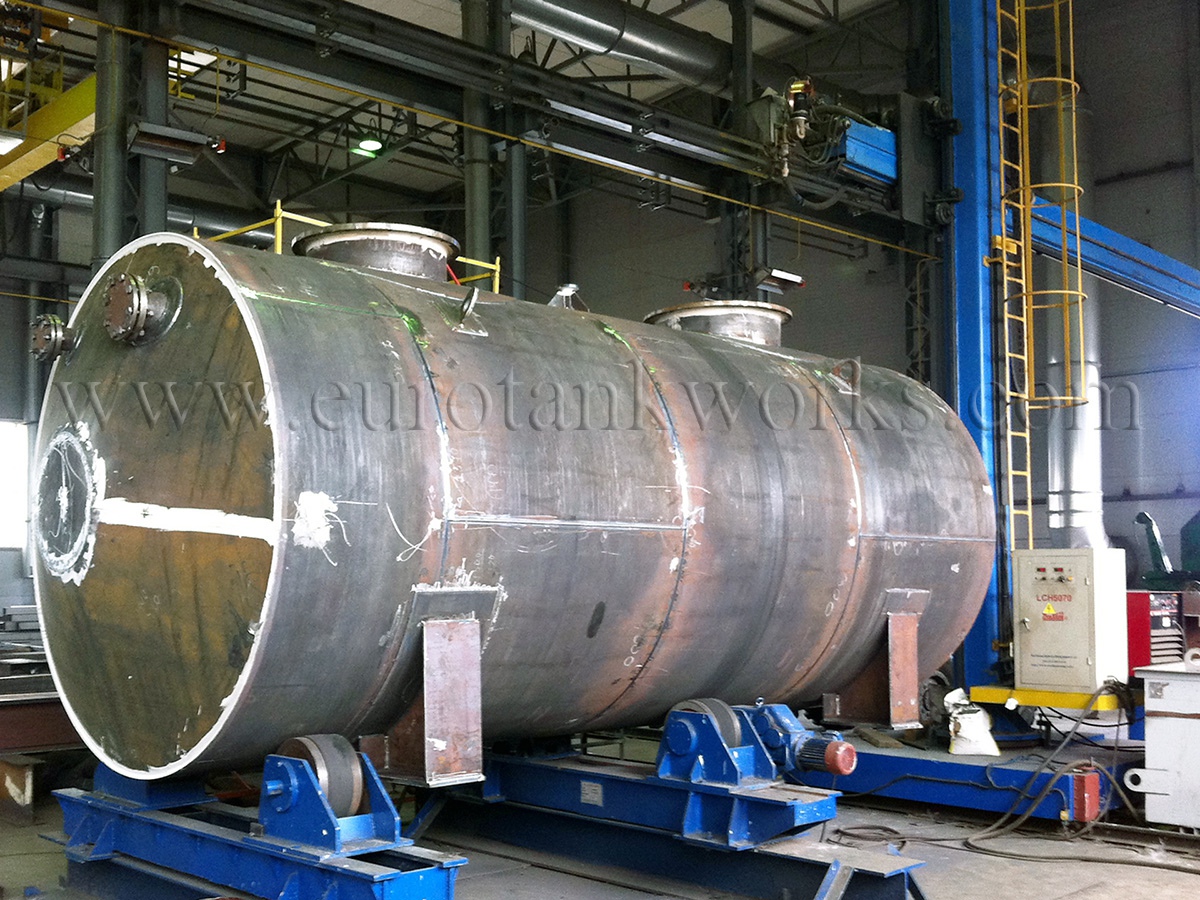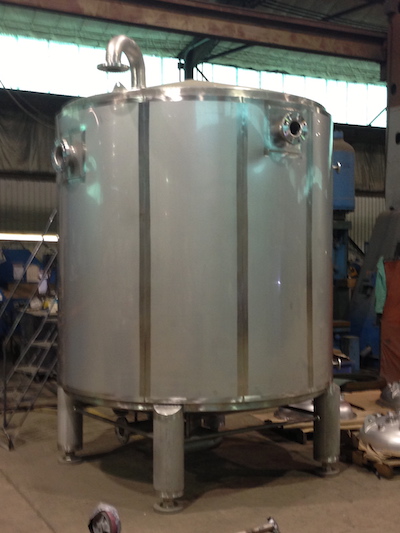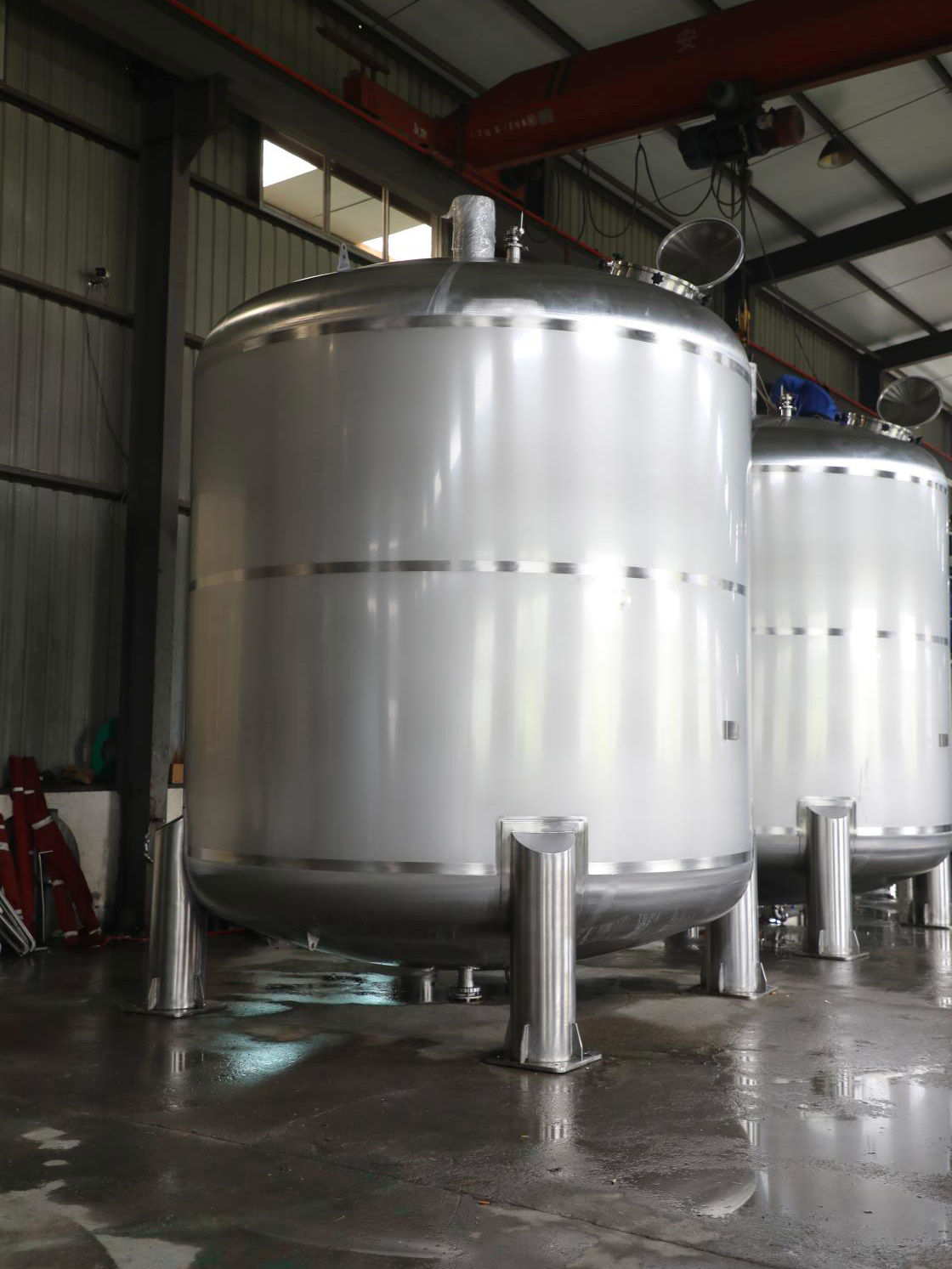The future of Storage Tank Manufacturing and sustainability
Wiki Article
Leading Innovations in Storage Tank Manufacturing: Increasing Effectiveness and Sustainability
The landscape of storage tank manufacturing is undertaking significant change as market leaders increasingly take on innovations focused on boosting both effectiveness and sustainability. Key improvements, including using smart innovations and sophisticated materials, are redefining operational criteria while attending to ecological problems. Additionally, modular storage tank styles and environmentally friendly manufacturing procedures existing new methods for resource optimization. As these trends proceed to develop, the implications for sector practices and long-lasting sustainability goals advantage further exploration. What particular innovations are setting the phase for this standard shift?Advanced Materials for Resilience
The evolution of storage tank manufacturing is significantly driven by the combination of innovative products made to improve longevity and efficiency. Typically, tank were constructed mainly from carbon steel, which, while reliable, is susceptible to rust and structural destruction over time. Texas Oil & Gas Storage Tank Fabrication Authority. Current innovations have seen the introduction of high-performance alloys, composite materials, and polymers that provide premium resistance to environmental elements and chemical exposureStainless steel and duplex alloys are now usual in applications needing heightened corrosion resistance, particularly in chemical or aquatic storage space environments. Additionally, composite materials, such as fiberglass-reinforced plastics, provide an exceptional strength-to-weight proportion while minimizing upkeep costs as a result of their non-corrosive nature. These developments not only expand the life expectancy of storage containers but likewise enhance their operational effectiveness.
Furthermore, the adoption of nanotechnology in finishings is confirming valuable in additional enhancing the safety residential properties of tank surface areas. These improvements not just decrease the frequency of assessments and repair work however additionally contribute to sustainability by lessening resource consumption and waste. As the industry continues to introduce, the emphasis on innovative products will certainly remain a keystone of storage tank manufacturing, ensuring security and reliability sought after applications.
Smart Checking Technologies
Advancements in smart surveillance innovations are changing the monitoring and upkeep of tank (Texas Oil & Gas Storage Tank Fabrication Authority). These innovations leverage the Net of Things (IoT), synthetic intelligence (AI), and advanced sensing unit innovations to improve operational efficiency and safety. By incorporating real-time information collection, drivers can keep track of tank problems, such as temperature level, pressure, and fluid levels, with unmatched precisionSmart tracking systems enable anticipating upkeep, permitting timely interventions before possible failings take place. This decreases downtime and reduces maintenance expenses, as drivers can address issues based on data-driven insights as opposed to reactive measures. Additionally, these modern technologies improve security methods by giving signals for leakages, overfills, or architectural weak points, significantly minimizing ecological dangers.
Cloud-based platforms facilitate centralized tracking across numerous areas, enabling drivers to make educated choices swiftly. Improved data analytics additionally contribute to enhancing supply monitoring, making certain that sources are made use of effectively.
As governing demands for ecological compliance become significantly strict, wise tracking technologies play a crucial duty in ensuring tank satisfy these standards. Overall, the fostering of these developments not only improves operational performance but also advertises sustainability in storage tank manufacturing and management.
Modular Tank Styles
Modular storage tank styles are changing the storage tank market by offering enhanced personalization choices that deal with certain customer demands. These designs not only help with customized options yet also offer space-saving configurations, making them ideal for varied atmospheres. As markets look for efficiency and flexibility, modular storage tanks present an engaging alternative to typical storage space remedies.Improved Customization Options
As makers seek to meet diverse client needs, enhanced personalization alternatives in storage tank style have come to be significantly prevalent. Modular container layouts exemplify this trend, permitting customized configurations that fit numerous operational demands. By making use of modular elements, suppliers can produce containers of different sizes, shapes, and capabilities, guaranteeing compatibility with certain applications.These adjustable containers can be adjusted to hold various kinds of liquids, including unsafe products, without endangering safety or performance. Additionally, modular layouts promote scalability, making it possible for business to expand their storage space capacity effortlessly as demand expands. This flexibility not only optimizes room application however additionally minimizes the general lifecycle costs linked with tank installation and upkeep.
Moreover, boosted modification options include advanced functions such as integrated surveillance systems, insulation, and specialized coatings that boost durability and efficiency. By using a variety of choices, manufacturers encourage clients to pick styles that line up with their operational objectives and sustainability campaigns.
Eventually, the rise of boosted personalization choices in storage tank manufacturing emphasizes a commitment to advancement, making it possible for markets to react efficiently to progressing market needs while improving total efficiency and environmental stewardship. (Texas Oil & Gas Storage Tank Fabrication Authority)
Space-Saving Configurations
Maximizing space performance has become a crucial consideration in storage tank design, particularly with the development of modular storage tank arrangements. These ingenious designs enable the assembly of containers in different setups, supplying flexibility and adaptability in space-constrained atmospheres. Modular containers can be conveniently delivered and set up, making them optimal for markets needing on-site storage services.The usage of modular styles not just maximizes area yet likewise improves scalability. Organizations can start with a smaller sized unit and expand their storage capacity by adding extra components as need rises. This step-by-step strategy minimizes ahead of time costs and enables for much better source administration. Modular containers can be personalized regarding size, material, and configuration, providing to specific operational demands.
Sustainability is likewise a vital advantage of modular container configurations. By making use of standard elements, producers can minimize waste throughout production and enhance the supply chain. In addition, these containers commonly feature improved insulation and energy-efficient designs, causing lower functional expenses.
Eco-Friendly Manufacturing Processes
As the demand for ecologically liable manufacturing grows, the storage tank sector is accepting green procedures to improve sustainability. This consists of the choice of sustainable materials, the execution of energy-efficient manufacturing strategies, and the adoption of waste reduction strategies. By prioritizing these practices, producers can significantly minimize their environmental influence while preserving item quality and performance.
Sustainable Material Choice
Sustainable material option is a keystone of environment-friendly manufacturing procedures in the storage tank industry. The selection of materials exceptionally influences not just the ecological footprint of production yet additionally the long life and performance of the storage tanks themselves. Using recycled or sustainably sourced products, such as advanced compounds and high-strength alloys, reduces the demand for virgin sources and lessens waste.Additionally, the integration of products with reduced embodied power adds to a decrease in greenhouse gas exhausts throughout the production lifecycle. For example, bio-based polymers and non-toxic coverings are getting grip, using both longevity and environmental advantages. These products not only satisfy the rigorous demands for safety and performance but also boost the tanks' resistance to deterioration, lengthening their life span and reducing maintenance prices.
Furthermore, manufacturers are progressively adopting life process assessment (LCA) methods to assess the ecological effect of material selections. By focusing on materials that are recyclable or eco-friendly, the storage tank market is taking substantial strides toward a round economic climate. This commitment to lasting material choice not just aligns with regulatory requirements yet likewise fulfills the expanding demand from ecologically mindful customers and services alike.
Energy-Efficient Production Methods
In the pursuit for minimizing ecological influence, energy-efficient production strategies have actually become essential elements in the storage tank making field - Oil & Gas Storage Tank Fabrication. These approaches not just decrease energy intake yet likewise improve functional efficiency and reduced overall manufacturing costsOne substantial technique is the adoption of sophisticated manufacturing modern technologies, such as computer system mathematical control (CNC) equipments, which optimize precision and minimize waste throughout the construction process. Automation and robotics have likewise obtained importance, enabling for streamlined procedures that call for less power and workforce. The combination of renewable power sources, like solar and wind power, into making plants has come to be increasingly usual, enabling business to reduce their reliance on fossil fuels.
Additionally, applying power monitoring systems aids optimize and keep track of energy use throughout the manufacturing cycle, identifying areas for renovation and ensuring conformity with ecological standards. These systems can bring about considerable decreases in energy intake, adding to a more lasting manufacturing procedure.
Waste Decrease Strategies
The implementation of energy-efficient manufacturing strategies normally results in an enhanced emphasis on waste decrease strategies in storage tank manufacturing. Firms are increasingly adopting practices that decrease product waste while optimizing source use. Trick strategies consist of lean manufacturing concepts, which improve processes to get rid of ineffectiveness and reduce excess stock.Reusing and recycling products is one more vital approach. Lots of suppliers are now buying innovations that promote the reclamation of scrap metal and other byproducts during manufacturing. This not only conserves basic materials however also lowers disposal expenses and environmental effect.
Moreover, suppliers are embracing digital technologies such as IoT and data analytics to keep track of and manage waste better. These tools can recognize waste generation factors and give insights for constant renovation. In addition, carrying out closed-loop systems allows companies to make use of waste products as inputs for new processes, promoting a round economic situation.
The search of accreditations such as ISO 14001 emphasizes the dedication to sustainability and waste reduction, positioning companies favorably in an open market. By systematically attending to waste, storage tank suppliers can achieve both economic and ecological benefits, driving ahead an extra sustainable industry.
Energy-Efficient Insulation Solutions
As suppliers look for to enhance the efficiency of storage tanks, they are turning to innovative energy-efficient insulation solutions that substantially decrease thermal losses. One famous pattern is using sophisticated materials such as aerogels and vacuum-insulated panels, which use extraordinary thermal resistance while being lightweight. These products not only lessen heat transfer yet likewise add to a decreased general impact and reduced setup expenses.
Executing these energy-efficient insulation remedies not just causes significant power cost savings yet additionally lines up with sustainability goals by minimizing greenhouse gas discharges connected with heating and cooling down procedures. As the market progresses, the concentrate on insulation technology will certainly stay critical in making sure that tank meet modern-day performance standards while adding positively to ecological sustainability.


Automation in Tank Production
Improvements in automation modern technology are revolutionizing storage tank manufacturing, significantly improving efficiency and accuracy. Automated systems currently play a vital duty in numerous stages of manufacturing, from material dealing with to welding and assembly. These technologies decrease human intervention, thereby lowering the likelihood of errors and raising throughput.Robotic systems are significantly made use of for jobs such as welding and surface area treatment, making certain regular high quality and minimizing production time. Automated quality assurance systems use advanced sensors and artificial intelligence algorithms to identify flaws in genuine time, allowing producers to address issues immediately and preserve high requirements.
The integration of Net of Points (IoT) modern technology in storage tank manufacturing helps with real-time surveillance of equipment and procedures. This connectivity causes enhanced functional insights, enabling manufacturers to enhance process and upkeep schedules. Predictive analytics can anticipate tools failings, better improving integrity and lessening downtime.
Enhanced Safety And Security Features
Incorporating enhanced safety and security functions right into storage tank manufacturing has actually ended up being a crucial emphasis for market leaders. As the demand for secure and dependable storage solutions expands, makers are taking on ingenious modern technologies and style concepts to mitigate dangers related to hazardous products.One significant development is the consolidation of advanced leak detection systems. These systems make use of sensing units that check storage tank honesty, allowing early identification of leaks and preventing environmental contamination. Furthermore, using double-walled tanks adds an additional layer of protection, making certain that if the inner wall fails, the outer wall has any kind of potential spills.
Furthermore, suppliers are executing pressure safety valve and overfill avoidance systems Our site to address potential overpressurization and overflow situations. These systems are designed to trigger instantly, considerably minimizing the danger of catastrophic failings.
The assimilation of wise tracking innovations allows for real-time data collection and evaluation. This capacity makes it possible for aggressive upkeep and quick reaction to any safety worries, making sure conformity with market guidelines.
Regularly Asked Concerns
Exactly How Do Storage Tank Innovations Influence Overall Operational Prices?
Innovations in storage tank manufacturing substantially lower operational prices by enhancing effectiveness, decreasing upkeep requirements, and enhancing resource usage. These advancements lead to decrease energy intake and extended devices life-span, ultimately boosting general monetary performance for companies.
What Industries Advantage Many From Advanced Storage Tank Technologies?
Industries such as oil and gas, chemicals, water therapy, and food handling substantially gain from advanced storage tank innovations. These developments improve safety and security, optimize source administration, and improve operational performance, eventually decreasing prices and environmental impact.Are There Details Certifications for Eco-Friendly Tank?
Yes, certain qualifications for eco-friendly tank exist, such as the Green Building Council's LEED qualification, ISO 14001 for ecological administration, and different industry-specific requirements that ensure compliance with sustainability and security policies.What Is the Lifespan of Modern Storage Storage Tanks Compared to Typical Ones?
Modern storage tanks typically possess a lifespan of 30 to 50 years, markedly exceeding conventional storage tanks, which commonly last 15 to 30 years. Advanced materials and making strategies add to this enhanced durability and long life.Exactly how Do These Developments Affect Regulatory Conformity in Tank Manufacturing?
Advancements in tank manufacturing boost regulative compliance by integrating innovative products, automated surveillance systems, and boosted style criteria. These developments assure adherence to safety and security standards, decrease environmental influence, and advertise sustainability within the industry.The evolution of storage space container manufacturing is significantly driven by the assimilation of sophisticated products made to boost durability and efficiency. Modular container layouts are revolutionizing the storage space container industry by using improved personalization choices that cater to details customer demands. Making the most of room performance has actually become a critical factor to consider in storage space tank style, especially with the introduction of modular tank arrangements - Storage Tank Manufacturing. Technologies in storage container manufacturing significantly decrease functional costs by boosting efficiency, reducing upkeep demands, and optimizing resource use. Modern storage space containers typically possess a lifespan of 30 to 50 years, substantially outmatching typical storage tanks, which frequently last 15 to 30 years
Report this wiki page